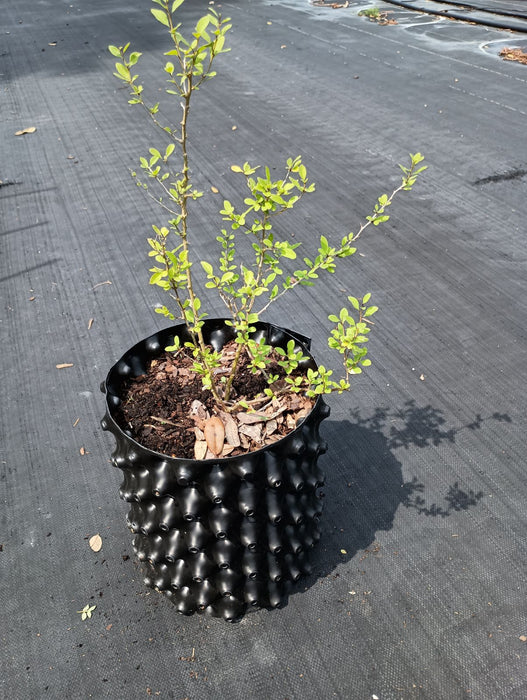
Goji Berry
Taste
Goji berries, also known as wolfberries, have a unique flavor that combines sweet, tart, and slightly bitter notes. Fresh goji berries are juicy and have a taste reminiscent of a mix between cranberries and cherries, with a slight herbal undertone. Dried goji berries, which are more commonly available, have a chewy texture and a concentrated sweetness similar to raisins. They are often used in teas, smoothies, trail mixes, and various culinary dishes to add a burst of flavor and nutritional benefits.
Best Growing Environment
Goji berries thrive in a variety of climates but prefer a sunny location with well-drained, fertile soil. They are highly adaptable and can be grown in both garden beds and containers. Goji berries perform best in soil with a pH level between 6.5 and 7.5. While they can tolerate some drought, they prefer a consistent watering schedule, especially during the establishment phase. Good air circulation and a sunny location help prevent fungal diseases and support vigorous growth.
Common Names
- Goji Berry
- Wolfberry
- Lycium barbarum (scientific name)
- Chinese Wolfberry
Average Height
Goji berry plants typically reach an average height of 3 to 6 feet (0.9 to 1.8 meters) and can spread about 4 to 6 feet (1.2 to 1.8 meters) wide. Pruning can help manage their size and shape, making them suitable for small gardens and container growing.
Growth Rate
The growth rate of goji berry plants is moderate. They can grow up to 12 inches (30 cm) per year under optimal conditions. Young plants focus on establishing a strong root system before producing significant above-ground growth. With proper care, goji berry plants can start producing fruit within two to three years of planting.
Sun Requirements
Goji berry plants require full sun to thrive, needing at least 6 to 8 hours of direct sunlight each day. Full sun exposure is crucial for optimal growth, flowering, and fruit production. In regions with intense heat, some afternoon shade can help protect the plants from scorching.
Cold Hardiness
Goji berry plants are quite hardy and can tolerate a range of temperatures. They are suitable for USDA zones 5 to 9. In colder regions, the plants can survive temperatures as low as -15°F (-26°C) with proper winter protection. Mulching around the base of the plant and using row covers can help protect them from severe frost.
Water Requirements
Goji berry plants require regular watering, especially during the first year of growth. Keep the soil consistently moist but not waterlogged. Once established, goji berries are relatively drought-tolerant but will produce better yields with consistent watering. During dry periods, ensure deep watering to encourage healthy root development. Mulching helps retain soil moisture and reduce the need for frequent watering.
Planting Guide
- Site Selection: Choose a location with full sun and well-drained soil. Ensure there is enough space for the plants to spread without crowding other plants.
- Soil Preparation: Amend the soil with organic matter such as compost to improve fertility and drainage. Goji berries prefer slightly alkaline soil, so adding lime may be beneficial if the soil is too acidic.
- Planting: Dig a hole twice the width of the root ball and just as deep. Place the plant in the hole, ensuring the top of the root ball is level with the surrounding soil. Backfill with soil, gently firming it around the roots to remove air pockets. Water thoroughly after planting.
- Mulching: Apply a 2 to 3-inch (5 to 7.5 cm) layer of mulch around the base of the plant, keeping it away from the trunk to prevent rot. Mulch helps retain moisture and suppress weeds.
- Staking: Young goji berry plants may benefit from staking to provide support and encourage upright growth. Use flexible ties and avoid damaging the stems.
Detailed Fertilizing Guide
- First Year: Fertilize young goji berry plants every 2 to 3 months with a balanced, slow-release fertilizer (such as 10-10-10). Follow the manufacturer's instructions for application rates based on plant size.
- Second Year Onward: Apply fertilizer three times a year—in early spring, early summer, and early fall. Use a balanced fertilizer (10-10-10) or one with a higher phosphorus content (5-10-10) to support growth and fruit development.
- Organic Options: Organic fertilizers such as compost, well-rotted manure, or fish emulsion can be used to provide a steady supply of nutrients.
- Micronutrients: Apply a micronutrient spray containing zinc, manganese, and iron periodically to address any potential deficiencies and promote overall plant health.

